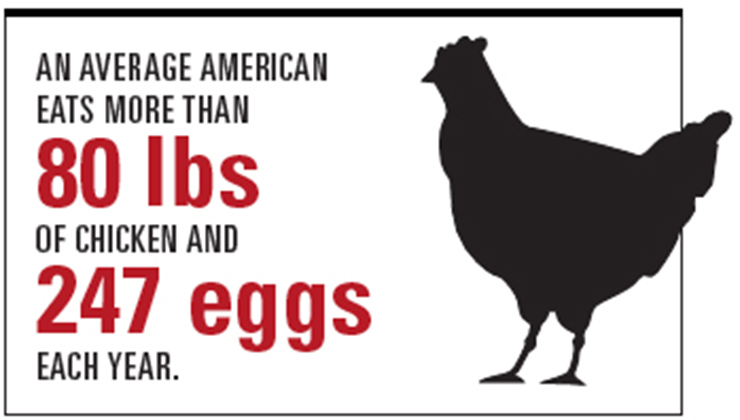Home > Alabama > Alabama Farm to Table > Good Eggs: Alabama Couple Wins Poultry Award
Good Eggs: Alabama Couple Wins Poultry Award

Gary and Barbara Wright work many hours each day at their poultry farm in Collinsville.
“We work from daylight to dark-thirty,” Barbara jokes. “Seven days a week, those chickens never take a break from laying eggs. They think it’s Easter every day around here.”
The Wrights run such a good poultry breeding operation that they were named 2012 Poultry Farm Family of the Year by the Alabama Poultry & Egg Federation.
“We don’t really know how we won, except that we certainly do run a family farm,” Gary says. “Our three kids – Amanda, Drew and Kevin – and son-in-law, Cliffton, all work full-time jobs, but every afternoon and on weekends they stop by to help. Our four grandkids are just babies, but I’m sure they’ll be helping once they get old enough.”
Gary and Barbara both come from generations of farmers, and they began to compile some farming acreage once they got married in 1977. Today, the Wright farm and the children’s nearby tracts span 600 acres, plus they lease an additional 500 acres to not only raise chickens, but also cattle, soybeans, corn and hay.
“For our poultry business, Barbara and I had two breeder hen houses built in 1995 and then signed a contract with Wayne Farms in Albertville,” Gary says. “We’ve been supplying eggs to Wayne Farms ever since.”

15,000 Eggs a Day
The way their business works is Wayne Farms provides the Wrights with 18,000 20-week-old laying hens and 2,000 males for the Wrights’ two breeder houses. The hens produce eggs on a daily basis and have an egg-laying life span that ends when they are about 65 weeks old, at which time they are sold and harvested for meat production.
Then, after about a month of cleaning and preparing the two empty chicken houses for the next batch, Wayne Farms delivers another 18,000 hens and 2,000 roosters, and the egg-laying process begins again.
“We get about 7,500 eggs per house per day at the peak of the laying season,” Gary says. “Wayne Farms gets all the eggs, and the hatchlings are raised until they reach maximum weight of around six pounds as broiler birds. Broilers are chickens bred and raised specifically for meat production.”
Gary adds that the poultry industry has been good to him and his family, and the Wrights have always done a fine job for Wayne Farms.
“It’s not a business where you’re going to get rich, but we’ve made a good living – all three of our kids went to college,” he says. “Even when grain prices have gone up, we’ve been able to keep our heads above water. Our family has always been farm-oriented, and we wouldn’t want it any other way.”

80,000 Jobs
For the overall Alabama poultry industry, the state today ranks behind only Georgia in U.S. broiler production, with Alabama processing 21.5 million chickens a week and 1.1 billion a year. Poultry accounts for 68 percent of Alabama’s overall agricultural revenue, with cash receipts for broiler chickens totaling about $2.8 billion annually.
“The entire broiler industry contributes $10 billion a year to the state’s economy if you add feed sales, propane gas for chicken houses, construction and hauling costs, equipment and other sideline enterprises,” says Ray Hilburn, membership director for the Alabama Poultry & Egg Association. “There are 80,000 jobs in Alabama related to poultry, and 10 big poultry processing companies in the state. About 2,700 individual growers raise chickens for those companies in 9,000-10,000 chicken houses throughout Alabama.”
Russia and China
Out of the $2.8 billion in annual cash receipts, nearly $400 million is derived from poultry exports, with Russia and China being the state’s two largest customers. The Alabama Poultry & Egg Association is also currently making a big push to delve into the India market.
“Probably our biggest competitor for foreign customers is Brazil because they have low labor costs and almost no government and environmental regulations, which is unfair but it’s just the way it is right now,” Hilburn says. “Brazil also has two or three annual corn crops while Alabama can only grow one, which gives them a feed advantage. However, one thing I can say is that Alabama truly prides itself on the quality of poultry we produce. Nobody beats Alabama for quality.”



